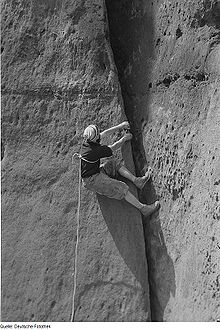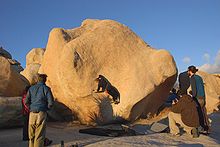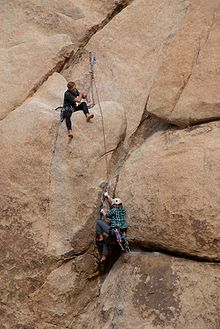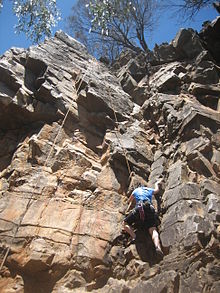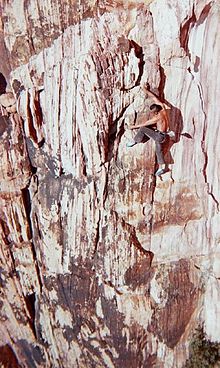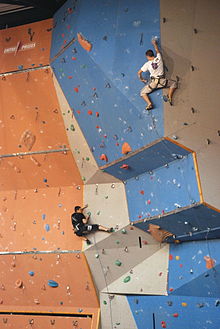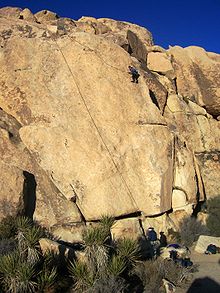- Rock climbing
-
Rock climbing History
Styles
Technique
Equipment and protection
Grades (difficulty of climb)
Terminology
Belaying
Abseilingv · Rock climbing also lightly called 'The Gravity Game', is a sport in which participants climb up, down or across natural rock formations or artificial rock walls. The goal is to reach the summit of a formation or the endpoint of a pre-defined route without falling. Rock climbing competitions have objectives of completing the route in the quickest possible time or the farthest along an ever increasingly harder route. Rock climbing is similar to scrambling (another activity involving the scaling of hills and similar formations), but climbing is generally differentiated because of its sustained use of hands to support the climber's weight as well as to provide balance.
Rock climbing is a physically and mentally demanding sport, one that often tests a climber's strength, endurance, agility and balance along with her or his mental control. It can be a dangerous sport and knowledge of proper climbing techniques and usage of specialized climbing equipment is crucial for the safe completion of routes. Because of the wide range and variety of rock formations around the world, rock climbing has been separated into several different styles and sub-disciplines that are described below.[1] While not an Olympic event, rock climbing is recognized by the International Olympic Committee as a sport.
Contents
History
Although rock climbing was an important component of Victorian mountaineering in the Alps, it is generally thought that the sport of rock climbing began in the last quarter of the nineteenth century in various parts of Europe. Rock climbing evolved gradually from an alpine necessity to a distinct athletic activity.
Aid climbing (climbing using equipment that acts as artificial hand- or footholds) became popular during the period 1920 - 1960, leading to ascents in the Alps and in Yosemite Valley that were considered impossible without such means. However, climbing techniques, equipment and ethical considerations have evolved steadily. Today, free climbing (climbing on holds made entirely of natural rock, using gear solely for protection and not for upward movement) is the most popular form of the sport. Free climbing has since been divided into several sub-styles of climbing dependent on belay configuration (described below).
Over time, grading systems have also been created in order to more accurately compare the relative difficulties of climbs.
Rock climbing basics
See also: Climbing techniquesAt its most basic, rock climbing involves climbing a route with one's own hands and feet and little more than a cushioned bouldering pad in the way of protection. This style of climbing is referred to as bouldering, since the relevant routes are usually found on boulders no more than 10 to 15 feet tall.
As routes get higher off the ground, the increased risk of life-threatening injuries necessitates additional safety measures. A variety of specialized climbing techniques and climbing equipment exists to provide that safety. Climbers will usually work in pairs and utilize a system of ropes and anchors designed to catch falls. Ropes and anchors can be configured differently to suit many styles of climbing, and roped climbing is thus divided into further sub-types that vary based on how their belay systems are set up. The different styles are described in more detail below, but, generally speaking, beginners will start with top roping and/or easy bouldering and work their way up to lead climbing and beyond.
Top-roping
In top-roping, an anchor is set up at the summit of a route prior to the start of a climb. Rope is run through the anchor; one end attaches to the climber and the other to the belayer, who keeps the rope taut during the climb and prevents long falls. This type of climbing is widely regarded as the safest type of climbing, with the lowest chance of injury.
Lead climbing
In lead climbing, one person, called the "leader", will climb from the ground up with rope directly attached to his or her harness. (and not through a top anchor) The second person, "belays" the leader by feeding out enough rope to allow upward progression without undue slack. As the leader progresses, he clips the rope through intermediate points of protection such as active cams, or passive protection such as nuts; this limits the length of a potential fall. The leader also may clip into pre-drilled bolts.
Because the climbing rope is of a fixed length, the leader can only climb a certain distance. Thus longer routes are broken up into several "pitches"; this is called "multi-pitching". At the top of a pitch, the "leader" sets up an anchor and then belays the "second" up to the anchor; as the "second" follows the route taken by the "leader" she removes the equipment placed along the way in order to use it again on the next "pitch." Once both are at the anchor, the "leader" begins climbing the next pitch and so on until the top is reached.
In either case, upon completion of a route, climbers can walk back down (if an alternate descent path exists) or rappel (abseil) down with the rope.
Grading systems
Climbing communities in many countries and regions have developed their own rating systems for routes. Ratings (or "grades") record and communicate consensus appraisals of difficulty. (Hence, there may be occasional disagreements arising from physiological or stylistic differences among climbers.) The ratings take into account multiple factors affecting a route, such as the slope of the ascent, the quantity and quality of available handholds, the distance between holds, ease of placing protection and whether advanced technical maneuvers are required. Whilst height of a route is generally not considered a factor, a long series of sustained hard moves will often merit a higher grade than a single move of the same technical difficulty. The typical rating system for top-roping and lead climbing is from 5.2-5.15b. There can be debate on the difficulty rating. Typically the rating for the hardest move on the wall will be the rating for the whole climb, although sometimes climbs are rated for endurance factor. For example, a climb can have multiple 5.11 moves with no rests and thus be rated 5.12. The most commonly used rating systems in the US are the Yosemite Decimal System and the "V" bouldering grade.
Climbing environments
Climbs can occur either outdoors on varying types of rock or indoors on specialized climbing walls. Outdoors, climbs usually take place on sunny days when the holds are dry and provide the best grip, but climbers can also attempt to climb at night or in adverse weather conditions if they have the proper training and equipment. However, night climbing or climbing in adverse weather conditions will increase the difficulty and danger on any climbing route.
Styles of rock climbing
Top roping Balthazar (12), in the Morialta Conservation Park near Adelaide, South Australia. Top roping is the most accessible style of climbing for beginners.
Most of the climbing done in modern times is considered free climbing -- climbing using one's own physical strength, with equipment used solely as protection and not as support—as opposed to aid climbing, the gear-dependent form of climbing that was dominant in the sport's earlier days. Free climbing is typically divided into several styles that differ from one another depending on the equipment used and the configurations of their belay, rope and anchor systems (or the lack thereof).
- Aid Climbing - Still the most popular method of climbing big walls. Progress is accomplished by repeatedly placing and weighting gear which is used directly to aid ascent and enhance safety.
- Free climbing - The most commonly used method to ascend climbs refers to climbs where the climber's own physical strength and skill are relied on to accomplish the climb. Free climbing may rely on top rope belay systems, or on lead climbing to establish protection and the belay stations. Anchors, ropes and protection are used to back up the climber and are passive as opposed to active ascending aids. Subtypes of free climbing are trad climbing and sport climbing. Free climbing is generally done as "clean lead" meaning no pitons or pins are used as protection.[2]
- Traditional climbing - Traditional or Trad Climbing involves rock climbing routes in which protection against falls is placed by the climber while ascending. Gear is used to protect against falls but not to aid the ascent directly.
- Sport Climbing - Unlike Traditional Rock Climbing, Sport Climbing involves the use of protection (bolts) or permanent anchors which are attached to the rock walls.
- Bouldering - Climbing on short, low routes without the use of the safety rope that is typical of most other styles. Protection, if used at all, typically consists of a cushioned bouldering pad below the route and/or a spotter, a person who watches from below and directs the fall of the climber away from hazardous areas. Bouldering may be an arena for intense and relatively safe competition, resulting in exceptionally high difficulty standards.
- Free soloing (not to be confused with free climbing) is single-person climbing without the use of any rope or protection system whatsoever. If a fall occurs and the climber is not over water (as in the case of deep water soloing), the climber is likely to be killed or seriously injured. Though technically similar to bouldering, free solo climbing typically refers to routes that are far taller and/or far more lethal than bouldering. The term "highball" is used to refer to climbing on the boundary between soloing and bouldering, where what is usually climbed as a boulder problem may be high enough for a fall to cause serious injury and hence could also be considered to be a free solo.
- Indoor climbing - Permits climbing in all types of weather and at all times of day. Used for improving climbing skills and techniques.
- Deep Water Soloing - Similar to free soloing in that the climber is unprotected and without a rope, but different in that if the climber falls, it is into deep water instead of on to the ground.
- Rope soloing - Solo climbing with a rope secured at the beginning of the climb allowing a climber to self-belay as they advance. Once the pitch is completed the soloist must descend the rope to retrieve their gear, and then reclimb the pitch. This form of climbing can be conducted free or as a form of aid climbing.
- Simul climbing - When two climbers move at the same time. The pseudo-lead climber places gear that the pseudo-follower collects. When the leader runs low on gear they construct a belay station where the follower can join them to exchange gear. The stronger climber is often the pseudo-follower since a fall by the follower would pull the leader from below towards the last piece of gear—a potential devastating fall for the leader. In contrast, a fall from the leader would pull the follower from above, resulting in a less serious fall. Most speed ascents involve some form of simul climbing but may also include sections of standard free climbing and the use of placed gear for advancement (i.e. partial aid or pulling on gear).
- Top roping - Climbing with the protection of a rope that's already suspended through an anchor (or also known as a "Top Rope System") at the top of a route. A belayer controls the rope, keeping it taut and preventing long falls. Most Indoor climbing or "gym climbing" is top roping on indoor purpose-made climbing walls although it is also common to boulder and sport climb indoors. Gym climbing is used as training for outside climbing, but some climb indoors exclusively. Due to its reduced risk, most beginners are introduced to climbing through top-roping.
Access to climbing areas
Indigenous culture considerations
Some areas that are popular for climbing, for example in the US and Australia, are also sacred places for indigenous peoples. Many such indigenous people would prefer that climbers not climb these sacred places and have made this information well-known to climbers. A well known example is the rock formation that Americans have named Devils Tower National Monument.[3] Native American cultural concerns also led to complete climbing closures at Cave Rock at Lake Tahoe,[4] Monument Valley, Shiprock and Canyon de Chelly.[5]
Climbing activities can sometimes encroach on rock art sites created by various Native American cultures and early European explorers and settlers. The potential threat to these resources has led to climbing restrictions and closures in places like Hueco Tanks, Texas,[6] and portions of City of Rocks National Reserve, Idaho.[7]
In Australia, the monolith Uluru (Ayers Rock) is sacred to local indigenous communities and climbing is banned on anything but the established ascent route (and even then climbing is discouraged).
Indigenous peoples are not the only cultures that object to climbing on certain rock formations. Professional climber Dean Potter kicked off a major controversy when he ignored long-accepted convention to scale Delicate Arch in 2006, resulting in strict new climbing regulation in Arches National Park.[8]
Climbing on Private property
Many significant rock outcrops exist on private land. Some people within the rock climbing community have been guilty of trespassing in many cases, often after land ownership transfers and previous access permission is withdrawn. In the U.S. the climbing community responded to access closures by forming the Access Fund. This is an "advocacy organization that keeps U.S. climbing areas open and conserves the climbing environment. Five core programs support the mission on national and local levels: public policy, stewardship and conservation (including grants), grassroots activism, climber education and land acquisition."[9] In the U.K. the British Mountaineering Council represents climbers and their interest of public access to crack, cliffs and boulders.
Environmental impact
Although many climbers adhere to "minimal impact" and "leave no trace" practices, rock climbing is sometimes damaging to the environment. Common environmental damages include: soil erosion, chalk accumulation, litter, abandoned bolts and ropes, human excrement, introduction of foreign plants through seeds on shoes and clothing and damage to native plant species, especially those growing in cracks and on ledges as these are often intentionally removed during new route development through a process commonly referred to as cleaning.
Clean climbing is a style of rock climbing which seeks to minimize some of the aesthetically damaging side effects of some techniques used in trad climbing and more often, aid climbing by avoiding using equipment such as pitons, which damage rock.
Climbing can also interfere with raptor nesting, since the two activities often take place on the same precipitous cliffs. Many climbing area land managers institute nesting season closures of cliffs known to be used by protected birds of prey like eagles, falcons and osprey.[10]
Many non-climbers also object to the appearance of climbing chalk marks, anchors, bolts and slings on visible cliffs. Since these features are small, visual impacts can be mitigated through the selection of neutral, rock-matching colors for bolt hangers, webbing and chalk.
Vandalism
Vandalism created by non-climbers is often mistakenly attributed to the climbing population, driving the implementation of new climbing restrictions.[11]
The most significant form of vandalism directly attributable to rock climbers is alteration of the climbing surface to render it more non-climber-friendly and/or slippery.
With the advent of hard, bolted sport climbing in the 1980s, many routes were "chipped" and "glued" to provide additional features, allowing them to be climbed at the standard of the day. This attitude quickly changed as the safer sport climbing technique allowed climbers to push hard without much risk, causing the formerly more-or-less fixed grades to steadily rise. Altering routes began to be seen as limiting and pointless.
Unlike trad climbing which generally uses protection only as a backup in case of falls, some forms of climbing—like sport climbing, canyoneering or, especially, aid climbing—rely heavily on artificial protection to advance, either by frequent falls or by directly pulling on the gear. Often these types of climbing involve multiple drilled holes in which to place temporary bolts & rivets, but in recent years an emphasis on clean techniques has grown.
Today, the charge of vandalism in climbing is more often a disagreement about the appropriateness of drilling and placing permanent bolts and other anchors. Typically in the USA, the first ascensionists decide where to place protection on a new route and later climbers are supposed to live with these choices. This can cause friction and retro-bolting when the route is perceived to be dangerous to climbers who actually lead at the grade of the climb, since the first ascensionists often lead at a higher grade and therefore don't require as much protection. Failing to properly design a new route at its grade is considered arrogant and very poor form. Even in strongholds of rock-climbing tradition like Yosemite National Park, many routes are being gradually upgraded to safer standards of protection.
BASE jumping
A few climbers, most prominently Dean Potter, are experimenting with taking small parachutes on long climbs. This is also known as Free Basing. BASE jumping is banned in some areas known for their rock climbing, notably Yosemite National Park.
Commercial applications
Skilled rock climbers have been employed in building a work of sculpture entitled Big Bambú atop the Metropolitan Museum of Art Roof Garden [12] and in repairing wind turbines.
See also
- Lists and glossaries
- List of climbers
- List of climbing topics
- List of climbing areas
- List of climbing equipment manufacturers
- Climbing organisations
- Glossary of climbing terms
- Climbing terminology
- Climbing command
- Glossary of knots common in climbing
- Rock climbing grades
- Related activities
- Mountaineering
- Scrambling
- Ice climbing
- Outdoor education
- Parkour (French technique of passing obstacles efficiently)
- Salto del pastor (aboriginal rock gymnastic sport of Canary Islands)
- Caving
- Bouldering
- Climbing competition
- International Federation of Sport Climbing
- Other
- Climbing injuries
- Lead climbing injuries
References
- ^ Mountaineering: The Freedom of the Hills, Swan Hill Press; 6th Revised edition edition (14 Oct 1997) ISBN 1840370017 ISBN 978-1840370010
- ^ Traditional Lead Climbing: A Rock ... - Google Books. Books.google.com. http://books.google.com/books?id=0OQZ8LUJYCAC&pg=PA13&lpg=PA13&dq=freeclimbing+define&source=bl&ots=bOi_hW8egs&sig=rh7friS5TWhuiHODjztR4yXsDJE&hl=en&ei=CP7XSffrFpK-Mo2yzeEO&sa=X&oi=book_result&ct=result&resnum=9#PPA11,M1. Retrieved 2010-12-23.
- ^ Devils Tower National Monument FINAL CLIMBING MANAGEMENT PLAN
- ^ Cave Rock Climbing Closure Becomes Permanent
- ^ Climbing Shiprock: Going Up On Native Land
- ^ Review of the Public Use Plan for Hueco Tanks SHP
- ^ Climbers seeking to overturn ban on scaling towers
- ^ Arches National Park Developing Formal Climbing and Canyoneering Plan
- ^ The Access Fund
- ^ Flatirons Climbing, wildlife closures
- ^ Thoughts on the Hueco Tanks troubles, by John Sherman
- ^ Big Bambu; April 27, 2010—October 31, 2010, Metropolitan Museum of Art Press Release,
Further reading
- Long, John (1998). How to Rock Climb! (How to Rock Climb Series). Helena, Mont: Falcon. ISBN 1-57540-114-2.
External links
- Rock climbing travel guide from Wikitravel
- Hot Aches Productions Films about Rock Climbing
v · d · eExtreme and adventure sports Boardsports Motorsports Water sports Rafting · Whitewater kayaking · Whitewater canoeing · Free-diving · Scuba diving · Coasteering · Jet Ski · WaterskiingMountaineering Free fall Flying Others Mountain biking · BMX · Inline skating · Parkour · Cliff diving · Paintball · Orienteering · Rappelling · Caving · Zip-lining · Freestyle skiing · Powerbocking · Stunt pogoing · Slacklining · Freestyle scooteringCategories:
Wikimedia Foundation. 2010.
Look at other dictionaries:
rock climbing — rock ,climbing noun uncount the activity of climbing the side of a mountain or large rock for enjoyment, usually using ropes and other equipment. Rock climbing is often simply called climbing. ╾ rock ,climber noun count … Usage of the words and phrases in modern English
rock climbing — rock .climbing n [U] the sport of climbing up very steep rock surfaces such as the sides of mountains >rock climber n … Dictionary of contemporary English
rock climbing — ► NOUN ▪ the sport or pastime of climbing rock faces, especially with the aid of ropes and special equipment … English terms dictionary
rock climbing — noun the sport or pastime of scaling rock masses on mountain sides (especially with the help of ropes and special equipment) • Hypernyms: ↑sport, ↑athletics, ↑climb, ↑mount * * * noun [noncount] : the sport or activity of climbing the steep sides … Useful english dictionary
rock climbing — UK / US noun [uncountable] the activity of climbing the side of a mountain or large rock for enjoyment, usually using ropes and other equipment. Rock climbing is often simply called climbing. Derived word: rock climber noun countable Word forms… … English dictionary
rock climbing — also rock climbing N UNCOUNT Rock climbing is the activity of climbing cliffs or large rocks, as a hobby or sport … English dictionary
rock climbing — uolų daugiakovė statusas T sritis Kūno kultūra ir sportas apibrėžtis Sportinio laipiojimo uolomis rungtys: individualusis laipiojimas ir porinės laipiojimo lenktynės. atitikmenys: angl. rock climbing; rock climbing events vok. Felsenmehrkampf, m… … Sporto terminų žodynas
rock-climbing — see rock climbing … English dictionary
rock climbing — laipiojimas uolomis statusas T sritis Kūno kultūra ir sportas apibrėžtis Savarankiška (atsiskyrusi nuo alpinizmo) uolų sporto šaka – įvairių maršrutų įveikimas laipiojant uolomis (neįlipant į viršūnes), naudojantis alpinizmo priemonėmis ir… … Sporto terminų žodynas
Rock-climbing equipment — Rock climbing History Styles Technique Equipment and protection Grades (difficulty of climb) Terminology Belaying Abseiling … Wikipedia
Share the article and excerpts
Direct link
https://en-academic.com/dic.nsf/enwiki/466031 Do a right-click on the link above
and select “Copy Link”
Rock climbing
- Rock climbing
-
Rock climbing History
Styles
Technique
Equipment and protection
Grades (difficulty of climb)
Terminology
Belaying
Abseiling

